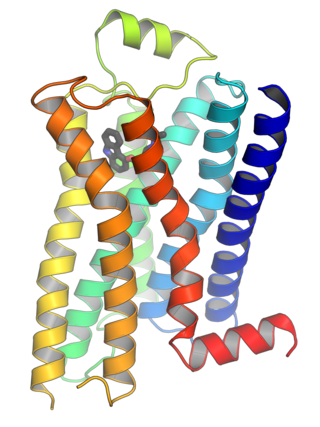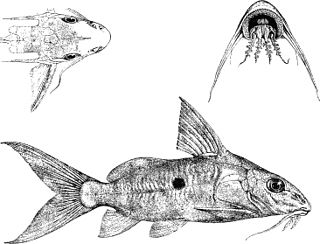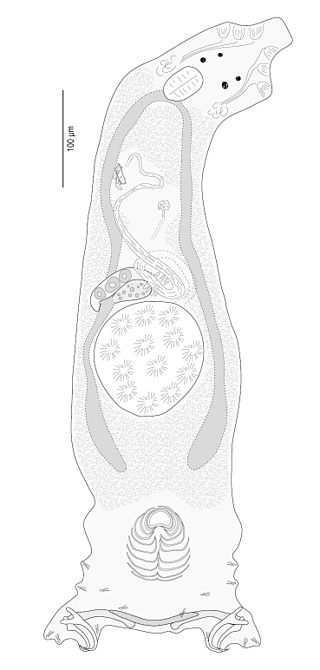
G protein-coupled receptors (GPCRs), also known as seven-(pass)-transmembrane domain receptors, 7TM receptors, heptahelical receptors, serpentine receptors, and G protein-linked receptors (GPLR), form a large group of evolutionarily related proteins that are cell surface receptors that detect molecules outside the cell and activate cellular responses. They are coupled with G proteins. They pass through the cell membrane seven times in the form of six loops of amino acid residues, which is why they are sometimes referred to as seven-transmembrane receptors. Ligands can bind either to the extracellular N-terminus and loops or to the binding site within transmembrane helices. They are all activated by agonists, although a spontaneous auto-activation of an empty receptor has also been observed.

G proteins, also known as guanine nucleotide-binding proteins, are a family of proteins that act as molecular switches inside cells, and are involved in transmitting signals from a variety of stimuli outside a cell to its interior. Their activity is regulated by factors that control their ability to bind to and hydrolyze guanosine triphosphate (GTP) to guanosine diphosphate (GDP). When they are bound to GTP, they are 'on', and, when they are bound to GDP, they are 'off'. G proteins belong to the larger group of enzymes called GTPases.
Secretin receptor family consists of secretin receptors regulated by peptide hormones from the glucagon hormone family. The family is different from adhesion G protein-coupled receptors.

Synodontis nummifer, known as the two spot synodontis, is a species of upside-down catfish native to the Congo Basin of Cameroon, the Democratic Republic of the Congo and the Republic of the Congo. It was first described by the Belgian-British zoologist George Albert Boulenger in 1899, based upon a holotype discovered in Léopoldville, Belgian Congo. The specific name "nummifer" comes from the Latin for "to bear a coin", which refers to the large spots on its sides.

Synodontis decorus is a species of upside-down catfish. Common names include clown catfish, clown synodontis, clown syno, clown squeaker, and barredtail squeaker.

Cichlidogyrus is a genus of monopisthocotylean monogeneans in the family Ancyrocephalidae. The type-species of the genus is Cichlidogyrus arthracanthusPaperna, 1960, by original designation. All the species of the genus are parasites on the gills of fish, namely African Cichlidae, Nandidae and Cyprinodontidae.

Pseudorhabdosynochus is a genus of monopisthocotylean monogeneans, included in the family Diplectanidae. The type-species of the genus is Pseudorhabdosynochus epinepheli .

The Diplectanidae are a family of monopisthocotylean monogeneans. They are all parasitic on the gills of fish. Diplectanids are small animals, generally around 1 mm in length. As parasites, they can be extremely numerous, up to several thousand on an individual fish.

Louis Euzet was a French parasitologist.
Pangasius kinabatanganensis is a species of shark catfish. It is a freshwater, benthopelagic and tropical fish, measuring up to 23.8 centimetres (0.78 ft) long. It is found in the Kinabatangan basin, in northeastern Borneo which is in the state of Sabah, Malaysia.
Hexabothriidae is a family of monogenean parasites. The family name was proposed by Emmett W. Price in 1942. The family includes 14-16 genera according to authors and about 60 species; all are parasitic on the gills of chondrichthyan fishes.

Echinoplectanum is a genus of monopisthocotylean monogeneans in the family Diplectanidae. All its species are parasites on the gills of fish; hosts recorded to date are all groupers, including coralgroupers and the Dusky grouper. So far, species of Echinoplectanum have been recorded only from fish caught off Australia, New Caledonia and in the Mediterranean Sea.

Lamellodiscus is a genus of monopisthocotylean monogeneans in the family Diplectanidae; all species of Lamellodiscus are small worms, parasitic on the gills of teleost fish.

Ancyrocephalidae is a family of monogenean flatworms. The family is considered as a "temporary name" in WorMS but includes a large number of genera and species.
Delane C. Kritsky is an American parasitologist who specialised on the Monogenea, a class of parasitic flatworms which are important ectoparasites of fishes. His research was mainly in the fields of taxonomy, faunistics, and phylogeny of the Monogenea.
Pseudorhabdosynochus bocquetae is a diplectanid monogenean parasitic on the gills of groupers. It has been described in 1984 by Guy Oliver and Ilan Paperna. The species was first described as Cycloplectanum bocquetae and transferred to the genus Pseudorhabdosynochus by Delane C. Kritsky and Mary Beverley-Burton in 1986.
Latericaecum is a genus of monopisthocotylean monogeneans, belonging to the family Diplectanidae.
Rhabdosynochus is a genus of monopisthocotylean monogeneans, belonging to the family Diplectanidae.
Protolamellodiscus is a genus of monopisthocotylean monogeneans in the family Diplectanidae. All species of Protolamellodiscus are parasites of marine perciform fishes of the families Lethrinidae, Nemipteridae, Serranidae and Sparidae.

Enterogyrus is a genus of monogeneans belonging to the family Ancyrocephalidae.









